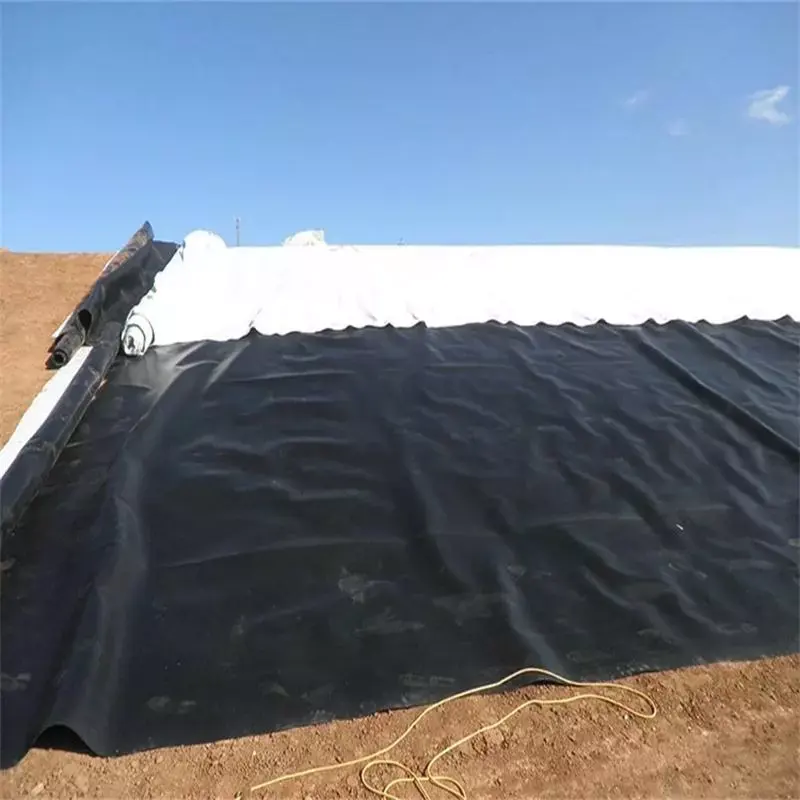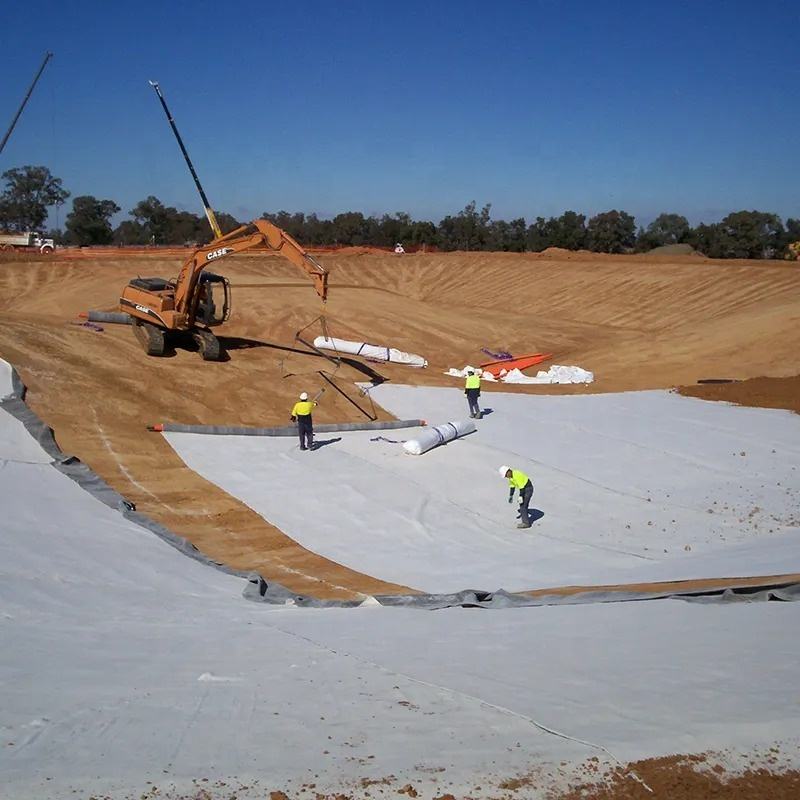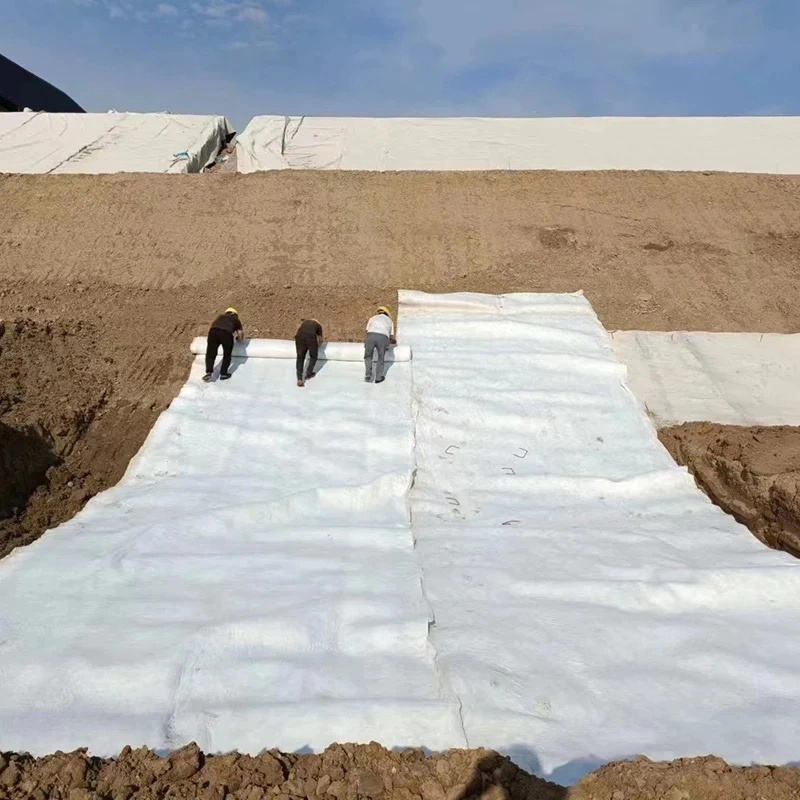Geotextiles for water conservancy projects, strengthening the safety line for flood prevention
Geotextiles for Water Conservancy Projects: Strengthening the Flood Control Safety Line
Extreme weather has been hitting more often worldwide lately. Days of heavy rain, sudden floods, and rising river levels—they all heap a lot of pressure on water conservancy stuff like dams, riverbanks, and reservoirs. For engineers and managers working on water projects, finding reliable materials to boost flood control has always been a big priority. Out of all the solutions out there, geotextiles have slowly become a "go-to" material for flood control work, thanks to what they can do. And when you pair them with geotextile waterproofing, they make a solid protective barrier for water facilities—really cutting down on flood damage risks.
1. Geotextiles: The Basic Backbone for Flood Control in Water Projects
Most people think of big structures first when they talk about flood control in water projects—like tall dams or wide drainage channels. But the "small" materials, geotextiles included, are what keep these big structures stable and long-lasting. Geotextiles are made from synthetic fibers; they’re strong, flexible, and don’t rust or wear down easily. Unlike old-school materials such as concrete or stone, they’re lighter, easier to move around, and simpler to install. That’s why they’re perfect for both emergency flood control jobs and long-term water facility upkeep.
When it comes to flood control, geotextiles mainly do two things: reinforce and stop water from seeping through. Take dam building, for example. The soil inside a dam gets worn down by water pretty easily. If water soaks into that soil, it softens the structure—sometimes even making the dam bend or break. Laying geotextiles between different soil layers blocks that water seepage. And geotextile waterproofing makes this even better. It’s not just a basic "waterproof layer"—it mixes the geotextile’s ability to breathe with waterproofing. So while it keeps outsi
de water from getting into the dam, it also lets moisture inside the soil evaporate slowly. That way, water vapor doesn’t build up and damage the dam. A lot of traditional materials can’t balance waterproofing and breathability like that—so geotextiles are way more reliable for flood control.
2. Why Geotextile Waterproofing Works: Tech Perks and Real Value
For water projects, how well flood control materials work directly affects how safe the whole project is. Traditional waterproof materials—things like asphalt felt and plastic sheets—have clear downsides when you use them for a long time. Asphalt felt ages fast and cracks if it’s out in the sun and rain too much; its waterproofing drops off fast after just a few years. Plastic sheets, on the other hand, aren’t flexible enough. If the soil settles or the dam shifts, they crack easily—and then the waterproofing fails.
Geotextile waterproofing fixes these problems. First off, it lasts a long time. The synthetic fibers in geotextiles can handle UV rays, hot and cold temperatures, and chemical damage. Even if they’re submerged in water for years or out in bad weather, they keep their waterproofing steady for over a decade. That long life means you don’t have to fix or replace flood control parts as often—saves water management teams time and money.
Second, geotextile waterproofing adapts well. Water facilities like riverbanks and reservoirs are usually built on bumpy ground, and the soil changes over time. Geotextiles are soft, so they fit tight against the soil. Even if the ground settles a little or shifts, they won’t crack. That adaptability matters a lot for flood control. When floods hit, the water pushes harder on dams or riverbanks. If the waterproof material cracks easily, the whole facility is at risk. Geotextile waterproofing can take that pressure and stay intact—so it keeps stopping water from seeping through.
Also, installing geotextile waterproofing is simple and fast. Pouring concrete needs complicated steps and takes a long time to dry. Laying geotextiles? You just clean the ground, unroll the material, and seal the edges. Even in emergencies—when you need to stop floods fast—a small team can lay a lot of geotextiles in a short time. That quick barrier can block water from spreading, which means less damage from floods.
3. Where Geotextiles Work in Different Flood Control Jobs
Water conservancy flood control covers a lot of jobs: dams, fixing riverbanks, reinforcing reservoirs, flood storage areas—you name it. With geotextile waterproofing backing them up, geotextiles work in nearly all these situations. And how you use them changes based on what each job needs.
For dams, geotextiles usually go in the middle and bottom parts—those are the spots where water seeps through most. Earth-rock dams have loose soil particles; water easily slips through the gaps. Laying geotextiles there blocks those gaps, and geotextile waterproofing makes sure water doesn’t get through the material itself. In dams that are high-risk, engineers sometimes lay two layers of geotextiles (with geotextile waterproofing) to make a double safety net against seepage. This works—you see it in lots of flood control jobs. For example, in river basins that get floods a lot, dams using this geotextile setup have survived several big floods without any seepage or shifting.
Fixing riverbanks is all about stopping river water from wearing the banks down and keeping them from collapsing. When rivers flow fast, they wash the banks nonstop—soil falls right into the water. Laying geotextiles on the bank’s surface helps, and geotextile waterproofing keeps river water from soaking into the bank’s soil. At the same time, geotextiles are strong enough to take the direct hit of the water flow. Some jobs mix geotextiles with gravel or concrete blocks, too. The geotextiles handle waterproofing and stop erosion; the gravel or concrete makes the bank more stable overall. This combo not only works better for flood control but also makes the riverbank last longer.
For reservoir reinforcement, geotextiles mostly go on the reservoir bottom and where the reservoir connects to the dam. The reservoir bottom stays in water almost all the time, so the soil gets soft easily. Laying geotextiles with geotextile waterproofing keeps the bottom soil from washing away—so the reservoir stays deep enough and holds enough water. Where the reservoir meets the dam, there’s often a gap between different materials. Geotextile waterproofing seals that gap, so water doesn’t seep through the joint—and the dam stays safe.
4. Key Things to Remember When Laying Geotextiles
Geotextiles and geotextile waterproofing work great, but how well they help with flood control depends a lot on how you install them. If you don’t lay them the right way, even the best geotextiles won’t do their job. So when building water projects, engineers need to watch for a few key things to make sure geotextile waterproofing works as well as possible.
First, you’ve got to clean and smooth the ground first before laying the geotextiles. The surface can’t have sharp stuff—stones, tree roots, pieces of glass. These things can poke holes in the geotextile while you’re laying it or later when it’s in use, and then the waterproofing fails. So before you start, workers need to pick up all the junk on the ground and smooth out any bumps. If the soil is soft, you have to pack it down first, too—otherwise, the geotextile might sink or shift later.
Next, you need to seal the geotextile joints really well. Joints are the weakest part of the whole geotextile waterproofing setup. If they’re not sealed tight, water will seep through. Right now, people use a few ways to fix joints: heat bonding, glue, or stitching. Heat bonding works for geotextiles that melt when heated—you use high heat to melt the edges of two geotextiles and stick them together, so there’s no gap. Glue works for more types of geotextiles, but you need glue that’s good at waterproofing and won’t break down. Otherwise, the joint might come apart when it’s in water for a long time. Stitching is usually just extra—helps make the joint stronger so it doesn’t tear.
Another thing to watch for: the direction you lay the geotextiles and how tight you pull them. Most of the time, you should lay them along the way the water flows. That way, the water doesn’t hit the geotextile as hard, and it won’t wash away. Also, you need to pull them just right—not too tight, because if the soil shifts, they’ll crack. Not too loose, either—they’ll wrinkle, and that messes up the waterproofing. Engineers usually use simple tools to check the tension while they’re working, so every part of the geotextile is laid right.
And finally, you have to check and maintain them after laying. Once the geotextile is down, workers need to look over the whole area carefully—check for holes, tears, or joints that aren’t sealed right. If you find a problem, fix it right away. Later, when it’s in use, you need to check it regularly too—especially after floods or heavy rain. Make sure it’s not damaged or shifted. Fixing small issues fast keeps geotextile waterproofing working well for years.
5. What’s Next for Geotextile Flood Control Tech
Materials science keeps getting better, and water projects need better flood control all the time. So geotextile tech—including geotextile waterproofing—is moving toward working better, being more eco-friendly, and being smarter.
When it comes to better materials, researchers are working on geotextiles that hold up even more. For example, adding tiny nanomaterials to the fibers makes the geotextiles more waterproof and slower to age. Some new geotextiles can even fix small cracks on their own. If the material gets a little damaged, special additives inside react with water or air to fill the crack—so the waterproofing works again. This self-fixing feature means you don’t have to maintain the geotextiles as much, and they last longer.
Being eco-friendly is another big focus. Old geotextiles are mostly made from synthetic fibers that don’t break down. When you throw them away, they can pollute the environment. To fix that, companies are making biodegradable geotextiles now. These are made from natural fibers—like hemp or bamboo—or synthetic fibers that break down naturally. They work just as well as old geotextiles for waterproofing and reinforcement, but when they’re done being used, they break down into harmless stuff. For water projects in sensitive areas—like river basins with lots of plants and animals—these biodegradable geotextiles (with geotextile waterproofing) are going to be the top choice.
Smarter geotextiles are also starting to pop up. Some companies are trying to put small sensors inside geotextiles. These sensors track things like water pressure, how fast water seeps through, and if the material is damaged—all in real time. They send the data to a management platform using wireless signals. Engineers can check how geotextile waterproofing is working anytime using the platform. If something’s wrong—like water seeping faster than normal—the system sends a warning right away. That lets workers fix the problem fast. This smart monitoring makes flood control management easier, and it helps find risks early—so big accidents don’t happen.
Conclusion
Flood control keeps getting harder, but geotextiles have become a material you can’t do without for water projects. Geotextile waterproofing is the key tech that makes geotextiles work so well—it helps reinforce dams, stop riverbanks from eroding, and protect reservoirs. It lasts a long time, adapts to different spots, and is easy to install—so water engineers trust it. And as it gets better materials, more eco-friendly, and smarter, it’ll be even more useful for flood control.
For water projects all over the world, picking geotextiles with good geotextile waterproofing isn’t just a way to make flood control better—it’s an investment in keeping things safe and sustainable for the long haul. As tech keeps improving, geotextiles will keep watching over water facilities, helping build a stronger flood control safety line. That way, people’s homes and lives stay protected from floods.







